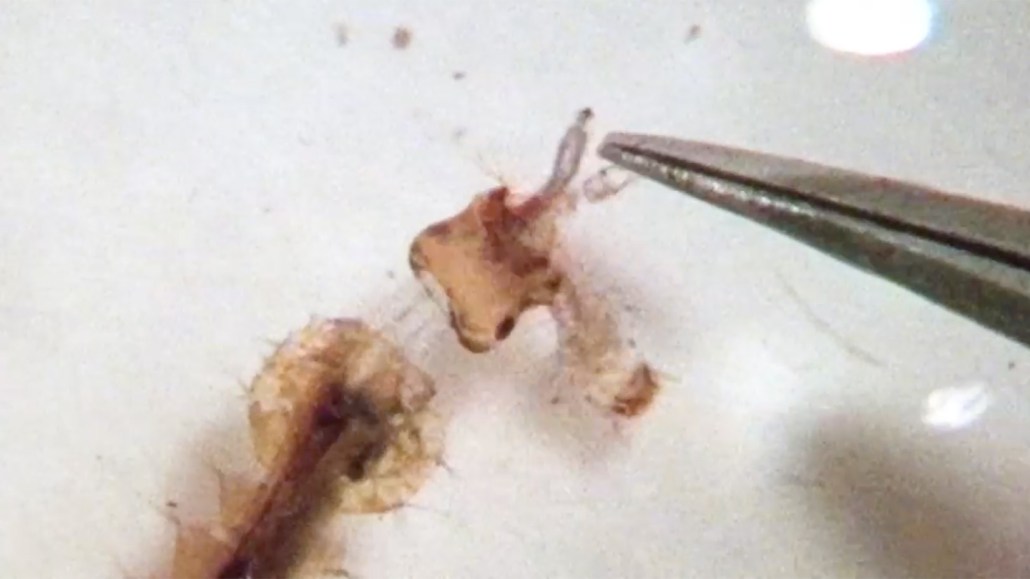
In an extreme pounce, a Psorophora mosquito larva (left) can shoot its blocky head forward to grab and gulp a different mosquito species.
R. Hancock et al/Ann. Entomol. Soc. Am 2022
A kind of teenager mosquito can suddenly shoot its head forward from its body — stretching its neck into a skinny cord — to bite into another youngster. And that’s just one of the ways young mosquitoes kill other mosquitoes, a new study shows.
Over decades, scientist-cinematographer Robert Hancock and colleagues have filmed attacks by these Psorophora ciliata and two other kinds of predatory mosquito larvae in unusual detail. Launching heads evolved independently in two of the kinds, he and colleagues say in their new study.
The third predator, a kind of Sabethes mosquito larva, uses its other end. Hanging head down in water, it needs only 15 milliseconds to grip prey with a hooking sweep of the breathing tube on its predatory butt, the researchers report October 4 in Annals of the Entomological Society of America.
The most dramatic pounce on film may be the neck-stretching snatch by the Psorophora larva. It might power this lunge by squeezing a rush of fluid to the head. When Hancock watches the mosquito’s body, segmented a bit like a string of alphabet-block beads, he can see two segments scrunching inward “accordion-like,” as if squirting fluid forward as the head shoots out.
Launching the head to reach the prey is one thing, but catching hold is another problem. The newly released video gives a clear view of a pair of brushes, one on each side of the head, that help with the grasp. As the head nears its victim, the brushes fan out into what the researchers call a “flimsy basketlike arrangement” that folds around the doomed prey.
Such an attack may startle people thinking of mosquito bites just as stealthy hypodermic blood-sucks. That’s the adult bite from females craving a nutritional supplement for egg-laying. Mosquito eggs, however, hatch in water, and larvae don’t assume their dandelion-wisp flying form for weeks. During the aquatic phase, these larvae don’t look, or dine, like adult forms at all.
Larvae don’t bite people, and many just filter out edible crumbs afloat in water. The meat eaters, however, pounce so fast that the human brain can’t parse it. Hancock has been fascinated ever since he was in a class in the 1980s seeing only a blur through the microscope as he tried to describe the feeding behavior. The Toxorhynchites mosquitoes that frustrated him then have turned out to be one of the groups that evolved head-launching larvae.
“If there’s any mosquito for all the mosquito haters to actually maybe not love but like, it’s Toxorhynchites,” says Hancock, now at Metropolitan State University of Denver. As iridescent adults they’re vegans, feeding largely on flower nectar. For larvae, it’s all meat, mostly other mosquitoes. Plus, he says, “They’re large, and they’re gorgeous.”
The new study found that the launch doesn’t extend as far as a head length, but Toxorhynchites attacks the prey larva vigorously. In the videos, “by the time you would catch sight of it, there would be like a half of larva … as it shoved this thing in like it was a hot dog eating contest,” Hancock says.
He and colleagues also caught on film a third kind of meat-eating mosquito, Sabethes, which are more flexitarian than carnivore. They still eat their meat at their head end, but the danger of getting snagged comes from their rear, the researchers’ videos show. Like many mosquito larvae, they often dangle head down in the water, taking in oxygen through a flexible siphon. It turns out that the breathing tube doubles as a type of food hook, capable of snaring a target in only several milliseconds.
“The thing about Sabethes is that they’re probably more like murderers because they really don’t ingest and consume entire prey larvae like the other two,” Hancock says. Feeding tests show that the insects do gain at least some nutrition from the nibbling.
A human watching the larvae hunt may wonder why we put so much money and chemistry into trying to kill the pests when their own tiny relatives do it so brilliantly. For one thing, mosquito larvae stay underwater, says entomologist Don Yee of the University of Southern Mississippi in Hattiesburg, who wasn’t involved in the study. The two neck-stretcher groups can’t lift into the air and fly to the next water-filled tire or tree hole. There, a Toxorhynchites, for instance, “likely would consume all other larvae,” he says. “[H]owever, there may be hundreds of such containers in the area.”
In contrast, the neck-stretching Psorophora mosquitoes live in larger bodies of water and could theoretically have more of an effect at knocking back mosquito numbers, Yee says. But under natural circumstances, the predators are unlikely to crash mosquito populations as humans would want. Yee compares it to the African savanna. In photos, “you can see how many wildebeest there are. The lions can’t really control them.” In nature, after all, predators that thrive don’t wipe out their own prey.






